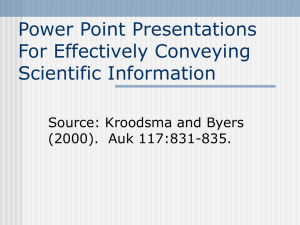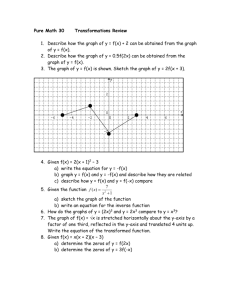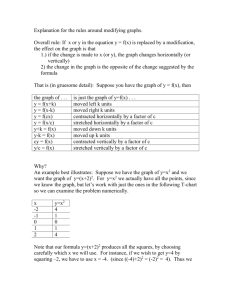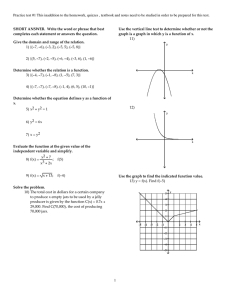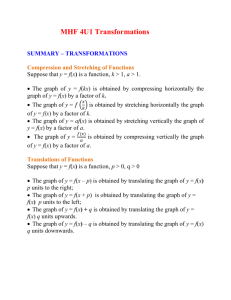Practice Problems for Test 1
advertisement
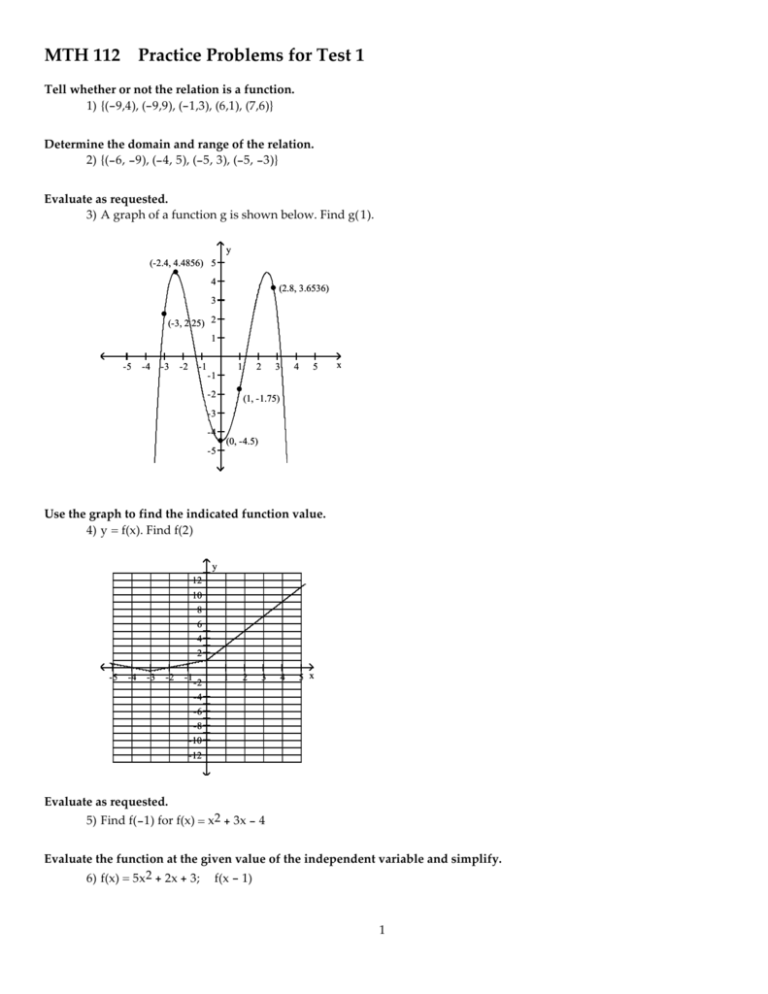
MTH 112 Practice Problems for Test 1
Tell whether or not the relation is a function.
1) {(-9,4), (-9,9), (-1,3), (6,1), (7,6)}
Determine the domain and range of the relation.
2) {(-6, -9), (-4, 5), (-5, 3), (-5, -3)}
Evaluate as requested.
3) A graph of a function g is shown below. Find g( 1).
y
(-2.4, 4.4856) 5
4
(2.8, 3.6536)
3
(-3, 2.25) 2
1
-5
-4
-3
-2
-1
1
2
3
4
5
x
-1
-2
(1, -1.75)
-3
-4
(0, -4.5)
-5
Use the graph to find the indicated function value.
4) y = f(x). Find f(2)
y
12
10
8
6
4
2
-5
-4
-3
-2
-1
-2
-4
1
2
3
4
5 x
-6
-8
-10
-12
Evaluate as requested.
5) Find f(-1) for f(x) = x2 + 3x - 4
Evaluate the function at the given value of the independent variable and simplify.
6) f(x) = 5x2 + 2x + 3; f(x - 1)
1
Find the domain of the function.
x + 2
7) f(x) = (x + 5)(x - 9)
8) f(x) = 7
x + 4
Identify the intercepts.
9)
y
10
5
-10
-5
5
10
x
5
10
x
-5
-10
10)
y
10
5
-10
-5
-5
-10
2
Determine whether the graph is the graph of a function.
11)
y
x
Use the graph to determine the functionʹs domain and range.
12)
6
y
5
4
3
2
1
-6 -5 -4 -3 -2 -1
-1
1
2
3
4
5
6 x
-2
-3
-4
-5
-6
Find the domain and range of the function represented in the graph.
Identify any relative maxima and/or minima.
13)
4
y
3
2
1
-2π
-π
-1
π
2π
x
-2
-3
-4
Find and simplify the difference quotient f(x + h) - f(x)
, h≠ 0 for the given function.
h
14) f(x) = 6x + 7
3
15) f(x) = 4x2 + 4x.
Identify the intervals where the function is changing as requested.
16) Increasing
5
y
4
3
2
1
-10 -8
-6
-4
-2
2
4
6
8
10 x
-1
-2
-3
-4
-5
Determine the intervals on which the function is increasing, decreasing, and constant.
17)
5
4
3
2
1
-5 -4 -3 -2 -1-1
-2
-3
-4
-5
y
1 2 3 4 5 x
Evaluate the piecewise function at the given value of the independent variable.
18) f(x) = 5x - 3 if x < -4 ; f(-3)
3x - 5 if x ≥ -4
Find the requested value.
19)
3x + 7, if x ≤ 0
f(5) for f(x) = 3 - 4x, if 0 < x < 4
x, if x ≥ 4
4
Graph the function.
20)
x - 1, for x > 0
f(x) = -5, for x ≤ 0
y
6
4
2
-6
-4
-2
2
6 x
4
-2
-4
-6
x + 5
21) f(x) = -4
-x + 5
if -8 ≤ x < 2
if x = 2
if x > 2
y
10
5
-10
-5
5
10
x
-5
-10
Determine if the graph is symmetric with respect to (circle choice): x -axis, y-axis, or origin.
22)
y
10
10 x
-10
-10
Determine algebraically whether the graph is symmetric with respect to the (circle choice) x -axis, the y-axis, and the
origin.
23) y = 2x2 - 3
5
Determine algebraically whether the function is (circle you answer) even, odd, or neither
24) f(x) = -2x3 + 3x
Circle the letter of your answer to the question.
25) How can the graph of f(x) = (x - 2)2 - 3 be obtained from the graph of y = x2 ?
A) Shift it 3 units horizontally to the right. Shift it 2 units downward.
B) Shift it 2 units horizontally to the left. Shift it 3 units downward.
C) Shift it 2 units horizontally to the left. Shift it 3 units upward.
D) Shift it 2 units horizontally to the right. Shift it 3 units downward.
Answer the question.
26) How can the graph of f(x) = (3x + 11)2 - 8 be obtained from the graph of y = x2 ?
A) Shift it horizontally 11 units to the right. Shift it 8 units down. Horizontal stretch by factor of 3
B) Shift it horizontally 11 units to the left. Shift it 8 units down. Horizontal shrink by factor of 3.
C) Shift it horizontally 11 units to the right. Shift it 8 units up. Vertical stretch by factor of 3
D) Shift it horizontally 11 units to the left. Shift it 8 units down. Vertical shrink by factor of 3
27) How can the graph of f(x) = -(x - 5)2 + 6 be obtained from the graph of y = x2 ?
A) Shift it horizontally 5 units to the right. Reflect it across the y-axis. Shift it 6 units down.
B) Shift it horizontally 5 units to the right. Reflect it across the y-axis. Shift it 6 units up.
C) Shift it horizontally 5 units to the left. Reflect it across the x-axis. Shift it 6 units up.
D) Shift it horizontally 5 units to the right. Reflect it across the x-axis. Shift it 6 units up.
Begin by graphing the standard square root function f(x) = x . Then use transformations of this graph to graph the
given function.
28) g(x) = - x - 1
10
8
y
6
4
2
-10 -8 -6 -4 -2-2
2 4
6 8 10 x
-4
-6
-8
-10
6
Begin by graphing the standard cubic function f(x) = x 3 . Then use transformations of this graph to graph the given
function.
29) h(x) = (x + 3)3 - 2
10
8
y
6
4
2
-10 -8 -6 -4 -2-2
2 4
6 8 10 x
-4
-6
-8
-10
Begin by graphing the standard quadratic function f(x) = x 2 . Then use transformations of this graph to graph the given
function.
30) h(x) = (x - 6)2 + 2
10
8
y
6
4
2
-10 -8 -6 -4 -2-2
2 4
6 8 10 x
-4
-6
-8
-10
Write an equation for a function that has a graph with the given characteristics.
31) The shape of y = x3 is shifted 4.5 units to the right.
32) The shape of y = ∣x∣ is reflected across the y-axis. The graph is shifted 6 units downward.
Find the domain of the function.
x - 4
33) h(x) = 3
x - 16x
For the pair of functions, find the indicated sum, difference, product, or quotient.
34) Find (f - g)(4) when f(x) = 2x2 + 2 and g(x) = x - 6.
Given functions f and g, perform the indicated operations.
g(x) = 9x - 4
35) f(x) = 7x - 1,
Find fg.
7
For the pair of functions, find the indicated sum, difference, product, or quotient.
36) Find (f/g)(-4) when f(x) = 5x - 5 and g(x) = 4x2 + 14x + 2.
Answer the questions.
37) For f(x) = 2x - 5 and g(x) = x + 3, what is the domain of f/g?
For the given functions f and g , find the indicated composition.
38) f(x) = 20x2 - 5x, g(x) = 14x - 3
(f∘g)(2)
Find the requested function value.
39) Find (g ∘ f)(-6) when f(x) = -4x - 5 and g(x) = -9x2 - 6x - 8.
Find the requested composition of functions.
40) Given f(x) = 5x + 13 and g(x) = 5x - 1, find (f ∘ g)(x).
For the given functions f and g , find the indicated composition.
7
4
,
g(x) = 41) f(x) = 8x
x + 6
(f∘g)(x)
42) f(x) = 4x2 + 2x + 5,
(g∘f)(x)
g(x) = 2x - 4
Find the domain of the composite function f∘g.
43) f(x) = 4x + 40,
g(x) = x + 3
44) f(x) = x + 4,
g(x) = 5
x + 6
Determine which two functions are inverses of each other.
x
3
45) f(x) = 3x
g(x) = h(x) = 3
x
46) f(x) = x - 6
4
g(x) = 4x - 6
h(x) = x + 6
4
Find the inverse of the one-to-one function.
47) f(x) = 4x + 5
48) f(x) = x + 8
8
Graph f as a solid line and f-1 as a dashed line in the same rectangular coordinate space. Use interval notation to give
the domain and range of f and f-1 .
49) f(x) = 3x - 1
10
y
8
6
4
2
-10 -8
-6
-4
-2
2
4
6
8
x
2
4
6
8
x
-2
-4
-6
-8
-10
50) f(x) = x2 - 8, x ≥ 0
10
y
8
6
4
2
-10 -8
-6
-4
-2
-2
-4
-6
-8
-10
9
Answer Key
Testname: PRACTICE PROBS TEST 1 FA09TST
1)
2)
3)
4)
5)
No
D = {-6, -4, -5}; R = {-9, 5, 3, -3}
-1.75
5
f(-1) = -6
6) 5x2 - 8x + 6
7) [-2, 9) ∪ (9, ∞)
8) (-∞, -4) ∪ (-4, ∞)
9) (1, 0), (0, -8)
10) (7, 0), (-7, 0), (0, -7)
11) No
12) domain: (-∞, ∞)
range: (-∞, 3]
13) Domain: [-π, 2π ]; Range: [-3, 3]
14) 6
15) 8x + 4h + 4
16) (3, ∞)
17) Increasing on (-3, 0); Decreasing on (-5, -3) and (2, 5); Constant on (0, 2)
18) -14
19) 5
20)
y
6
4
2
-6
-4
-2
2
4
6 x
5
10
-2
-4
-6
21)
y
10
(2, 7)
5
-10
(2, 3)
-5
(-8, -3)
x
-5 (2, -4)
-10
22) x-axis
23) y-axis only
24) Odd
25) D
10
Answer Key
Testname: PRACTICE PROBS TEST 1 FA09TST
26) B
27) D
28)
10
8
y
6
4
2
-10 -8 -6 -4 -2-2
2
4
6 8 10 x
2
4
6 8 10 x
2
4
6 8 10 x
-4
-6
-8
-10
29)
10
y
8
6
4
2
-10 -8 -6 -4 -2
-2
-4
-6
-8
-10
30)
10
y
8
6
4
2
-10 -8 -6 -4 -2
-2
-4
-6
-8
-10
31) f(x) = 0.5(x - 4.5)3
32) f(x) = 3.5∣-x∣ - 6
33) (-∞, -4) ∪ (-4, 0) ∪ (0, 4) ∪ (4, ∞)
34) 36
35) 63x2 - 37x + 4
36) - 5
2
37) (-3, ∞)
38) 12,375
39) -3371
40) 25x + 8
11
Answer Key
Testname: PRACTICE PROBS TEST 1 FA09TST
41)
32x
7 + 48x
42) 8x2 + 4x + 6
43) (-∞, ∞)
44) (-∞, -6) or (-6, ∞)
45) f(x) and g(x)
46) g(x) and h(x)
x - 5
47) f-1 (x) = 4
48) f-1 (x) = x2 - 8
49)
10
y
8
6
4
2
-10 -8
-6
-4
-2
2
4
6
8
x
-2
-4
-6
-8
-10
f domain = (-∞, ∞); range = (-∞, ∞)
f-1 domain = (-∞, ∞); range = (-∞, ∞)
50)
10
y
8
6
4
2
-10 -8
-6
-4
-2
2
4
6
8
x
-2
-4
-6
-8
-10
f domain = (0, ∞); range = (-8, ∞)
f-1 domain = (0, ∞); range = (-8, ∞)
12


